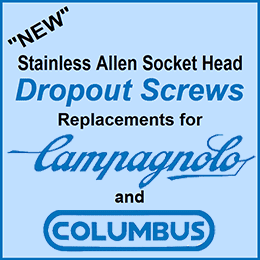Bayliss-Wiley Unit Hub: Ahead of its time
 Wed, September 13, 2017
Wed, September 13, 2017 
I got my first serious lightweight bike in 1950. It was a modest Dawes made of Reynolds 531 tubing. It had a cottered steel crank with a single chainring, and a Simplex derailleur with 3 x 1/8 inch sprockets.
The rear hub was a Bayliss-Wiley “Unit” hub as it was known. (Pictured above.) Freewheels had always been a separate item that screwed to the hub, this one had the freewheel built into the hub as a single unit, hence its name.
Today we call this a cassette hub and is the standard equipment on most high end and even moderate lightweight bikes.
The Bayliss-Wiley Unit hub was introduced in 1938, and was produced until 1957. Not particularly lightweight it was never considered to be racing equipment, but was used by club cyclists, tourists, and young kids like me who were just starting out.
Looking back it was really ahead of its time and it would be 30 years later that the Japanese company Suntour introduced another, and failed. It wasn’t until the top two manufacturers, Shimano and Campagnolo introduced their cassette hubs that people took them seriously.
The freewheel was always considered an item that would wear out long before the hub, therefore at the time the logic was to have it be a separate component that could be unscrewed from the hub and replaced. But if one thinks about it, it is the sprockets that wear out, not the free wheel. So a cassette also makes sense.
 It wasn’t until freewheels went beyond six sprockets to 7, 8, 9, and 10, that an all in one unit or cassette hub was considered practical.
It wasn’t until freewheels went beyond six sprockets to 7, 8, 9, and 10, that an all in one unit or cassette hub was considered practical.
The Bayliss-Wiley Company was located in Tyseley, Birmingham, England and was founded by Cecil Bayliss and Arthur Wiley in 1919.
The company had what we would call today a niche market. They produced inexpensive but high quality bicycle components. Bayliss-Wiley kept the British working man on the road, back in the day when the bicycle was often the only form of transport for the working class.
They primarily made hubs, single speed freewheels, and bottom brackets, the parts that wore out and needed regular replacement. The company thrived through the 1920s, 30s and 40s, but not surprisingly declined in the late 1950s, when the British working man abandoned the bicycle and started buying cars for the first time.
Taken over by Reynold Chains Ltd., the Bayliss-Wiley name finally disappeared in 1969. One of the most recognizable brand names when I started cycling in the 1950s, but not too many of today's generation will have heard of Bayliss-Wiley, even in the UK.
You can read more on Ebykr.com
This article was originally posted in April 2011



















Reader Comments (8)
I have come across old Bayliss parts but I knew nothing of the background.
And I had forgotten about the SunTour freehub, I almost bought one once, but couldn't afford it back in the day.
Your article shows that nothing is really new. Aluminium was first used to make frames in the late 19th century and titanium in the early 20th.
Seems remiss not to mention the later Very French Maillard Helicomatic Hub :-)
Wrong emoji for Helicomatic, it should be :-( give how bad the bearings were and how quickly they wore out.
Don't forget about Shimano 6 speed uniglide cassettes. Shimano 6 & 7 speed cogsets were available as cassettes OR freewheels.
Hi Dave,
Another reason for the development of the cassette type hub ( or an advantage) is it moved the chain side bearing (s) outboard making the hub much stronger. This then allowed engineers to make them lighter too. During the mid 1980's when mountain bikes were more popular than road bikes I saw several Shimano Dura Ace rear hubs develop a crack right down the center of the hub where it necked down. Shimano did warranty these hubs and probably left a little more material in the middle. Even though they were meant for road use, many high end mountain bikes had them too.
When I saw your post the first time, I liked the idea of a modern version and started looking. Currently there is a DMR Short Block 1 speed to 6 speed cassette hub 32 hole 36 hole on sale on ebay UK for £30. I like it because you get the benefit of freehub axle strength with a shallow dish to the wheel. No one needs 11 speeds at the back and you can do a custom cluster by shuffling individual shimano sprockets and spacers.
I found a set of Bayliss wiley front & rear roadster hubs, excellent condition even though lying in the scrap lots for decades.
I got them spoked 32 & 40 on regular rims, and found these to be a bicyclist's dream.
I replaced the inner steel cups, and balls (bearing) and they are just like new.